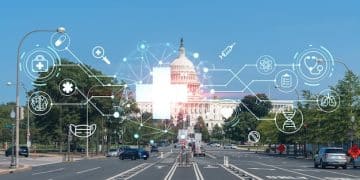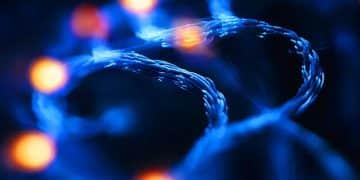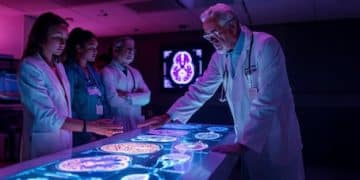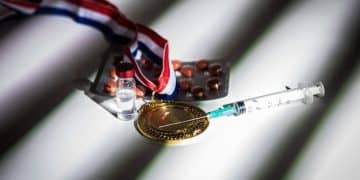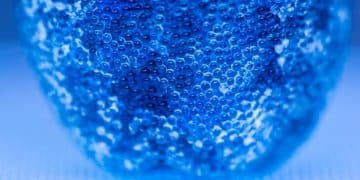Bioprinting Human Organs: Advances & Ethics
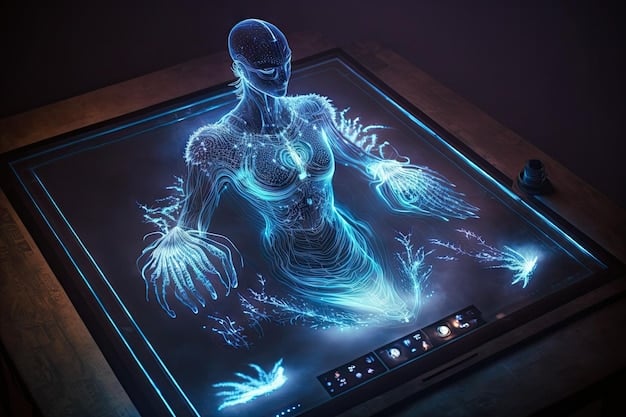
Bioprinting human organs is rapidly transforming medicine, offering hope for addressing donor shortages and developing personalized treatments, while simultaneously raising complex ethical questions about human identity, equitable access, and the very definition of life.
The dawn of bioprinting human organs: what are the latest advances and ethical considerations? represents a monumental leap in medical science, holding the promise of a future where organ shortages could become a relic of the past. This groundbreaking technology is not merely an incremental improvement; it signifies a paradigm shift in how we approach transplant medicine, drug development, and even our fundamental understanding of biological systems.
Understanding Bioprinting: The Core Technology
Bioprinting, in essence, is the application of 3D printing principles to biological materials. Instead of plastic or metal, bioprinters use “bio-inks” composed of living cells, growth factors, and biocompatible polymers to construct complex tissue and organ structures layer by layer. This precise placement of cells allows for the creation of intricate architectures that mimic the natural complexity of human organs, offering a level of control previously unimaginable.
The fundamental process involves several key stages. First, a digital model of the desired organ or tissue is created, often derived from patient-specific imaging data like MRI or CT scans. This model then guides the bioprinter, depositing bio-inks in a pre-programmed pattern. The choice of bio-ink is critical, as it must support cell viability, proliferation, and differentiation while providing structural integrity. Various bioprinting techniques exist, each with its own advantages and limitations, tailored for different applications and cell types.
Types of Bioprinting Techniques
Different bioprinting methods offer unique capabilities for constructing diverse biological structures. The selection of a technique depends heavily on the specific tissue or organ being targeted, the type of cells used, and the desired resolution and scale of the final construct. Researchers are constantly refining these methods, often combining approaches to leverage their individual strengths.
- Extrusion-based bioprinting: This method uses pneumatic or mechanical force to push continuous filaments of bio-ink through a nozzle. It’s versatile for printing various bio-inks and can produce larger structures, making it suitable for macroscopic constructs like bone or cartilage scaffolds.
- Inkjet bioprinting: Similar to a conventional inkjet printer, this technique dispenses picoliter droplets of bio-ink onto a substrate. It offers high resolution and cell viability but is limited by the viscosity of the bio-inks it can process. Ideal for creating cellular patterns and drug screening platforms.
- Laser-assisted bioprinting (LAB): LAB uses a pulsed laser to generate a high-pressure bubble that propels a cell-laden liquid from a donor substrate onto a collector. This method boasts high resolution and minimal cell damage, making it excellent for delicate cellular structures, though it can be slower and more complex.
The development of sophisticated bio-inks is equally crucial. These materials must not only be biocompatible but also provide the necessary biochemical and mechanical cues to guide cell behavior. Researchers are exploring hydrogels, decellularized extracellular matrix materials, and even synthetic polymers to create optimal environments for cell growth and tissue maturation. The goal is to create a scaffold that gradually degrades as cells secrete their own extracellular matrix, leaving behind a functional, native-like tissue.
The progression of bioprinting from conceptual models to tangible, laboratory-grown tissues highlights remarkable advancements in materials science, cell biology, and engineering. While still in its nascent stages for full organ fabrication, the ability to create functional tissue models for research, drug testing, and even rudimentary therapeutic applications is already revolutionizing biomedical science. This foundational understanding sets the stage for appreciating the more complex advancements in organ bioprinting.
Latest Advances in Bioprinting Human Organs
The field of bioprinting human organs has seen breathtaking progress, moving from theoretical possibility to the creation of increasingly complex and functional tissue structures. While fully transplantable, vascularized human organs remain the ultimate goal, significant milestones have been achieved in printing smaller, functional tissues that serve critical roles in research and pre-clinical applications. These advancements are driven by innovations in printer technology, bio-ink development, and cell culture techniques.
One of the most exciting areas of development is the printing of vascular networks. Organs, by their very nature, require intricate systems of blood vessels to supply nutrients and remove waste. Historically, creating these networks within larger bioprinted constructs has been a major hurdle. Recent breakthroughs involve advanced techniques like fugitive ink printing, where a temporary, sacrificial ink is printed in the shape of vessels and then removed, leaving behind hollow channels that can be endothelialized. This allows for the creation of perfused tissues, a crucial step towards viable organ substitutes.

Another major leap involves the use of induced pluripotent stem cells (iPSCs). By deriving patient-specific iPSCs, scientists can generate any cell type needed for organ construction, effectively creating “designer organs” that are immunologically matched to the recipient. This eliminates the risk of immune rejection, a chronic problem in traditional organ transplantation. The ability to differentiate iPSCs into specialized cells like cardiomyocytes, hepatocytes, or nephrons and then organize them into functional units is at the forefront of regenerative medicine.
Breakthroughs in Specific Organ Systems
While a complete heart or kidney is still some way off, progress in specific organ systems is remarkable. Researchers have successfully bioprinted functional liver spheroids that mimic certain metabolic activities of the liver, useful for drug toxicity screening. Similarly, complex kidney structures, while not yet performing full filtration, are providing invaluable models for understanding kidney disease and testing new therapies. The complexity inherent in organs like the lung, with its intricate air sacs and vascularization, presents a greater challenge, but initial progress in printing airway structures is promising.
- Cardiac Tissue: The creation of beating cardiac patches that can integrate with native heart tissue after implantation has shown potential for treating myocardial infarction. These patches contain cardiomyocytes that contract in synchrony.
- Skin Grafts: Bioprinted skin, complete with hair follicles and sweat glands, has been successfully produced and even tested in pre-clinical models, offering hope for burn victims and reconstructive surgery.
- Bone and Cartilage: Simpler tissues like bone and cartilage have seen significant success, with bioprinted scaffolds promoting regeneration in injured areas. Clinical trials for cartilage repair using bioprinted constructs are already underway.
The integration of artificial intelligence and machine learning is also accelerating advances in bioprinting. AI algorithms can optimize print parameters, predict cell behavior, and even design more efficient tissue architectures. This computational power enables faster iteration and refinement of bioprinting processes, shaving years off traditional trial-and-error research. Furthermore, the development of multi-material bioprinters capable of handling diverse bio-inks simultaneously is opening doors to printing structures with heterogeneous cell populations and complex extracellular matrix compositions, mirroring nature’s designs more closely.
These advances, from improved vascularization to patient-specific cells and AI-driven optimization, collectively paint a picture of a rapidly evolving field poised to deliver transformative medical solutions. The journey towards functional, transplantable organs is fraught with challenges, but the momentum and ingenuity in scientific labs worldwide suggest that bioprinting will undoubtedly reshape the landscape of healthcare.
Challenges in Bioprinting Complex Organs
Despite the remarkable progress, bioprinting truly complex, functional human organs for transplantation remains a formidable scientific and engineering challenge. The hurdles are multifaceted, spanning biological, technical, and logistical domains. Overcoming these requires interdisciplinary collaboration and sustained research efforts.
One of the primary biological challenges lies in achieving sufficient vascularization throughout a large bioprinted organ. Without a dense, interconnected network of blood vessels, cells deep within the construct cannot receive oxygen and nutrients or remove waste products, leading to cell death and tissue necrosis. While significant strides have been made in printing rudimentary vascular channels, integrating these into a fully functional, self-sustaining circulatory system that can support an entire organ is immensely difficult. The complexity of natural vascular branching, from large arteries to microscopic capillaries, is incredibly challenging to replicate with current bioprinting resolution and speed.
Another biological hurdle is the long-term viability and functionality of bioprinted cells and tissues. Cells must not only survive the printing process but also proliferate, differentiate appropriately, and integrate seamlessly into a functional tissue. Maintaining cell viability during the printing process itself is critical, as the forces exerted by the printer can damage delicate cells. Moreover, guiding cells to mature into specialized cell types that perform the specific functions of an organ (e.g., hepatocytes in a liver or nephrons in a kidney) outside of the body is a complex biological puzzle. Replicating the intricate signaling pathways and microenvironmental cues that regulate organ development in vivo is a major research focus.
Technical and Engineering Limitations
From an engineering perspective, current bioprinters face limitations in terms of speed, resolution, and scalability. Printing an entire organ with billions of cells and intricate structures within a timeframe that maintains cell viability is a monumental task. Achieving the micron-level resolution required to replicate fine anatomical details, such as individual nephrons in a kidney or alveoli in a lung, while also printing at a macroscopic scale, presents a significant technical paradox. Furthermore, the development of bio-inks that are both printable and can provide the necessary mechanical support and biological cues for living cells remains an active area of research.
- Scale and Speed: Current bioprinting methods are too slow to produce organs of clinically relevant size within typical operating room timelines, and scaling up these processes while maintaining cell viability and structural integrity is a major challenge.
- Resolution and Complexity: Replicating the microscopic architecture and cellular heterogeneity of organs such as the brain or the intricate filtration units of a kidney is beyond current printing resolution capabilities.
- Bioreactor Maturation: Once printed, complex organs need sophisticated bioreactor systems that can mimic the body’s internal environment to allow the tissues to mature, develop vascularization, and become fully functional—a process that can take weeks or even months.
Beyond the technical and biological complexities, ethical and regulatory considerations also pose significant challenges. Defining the safe and ethical pathways for translating bioprinted organs from the lab to the clinic requires careful consideration of patient safety, equitable access, and the societal implications of creating “designer” organs. The regulatory frameworks for such novel medical devices are still evolving, adding another layer of complexity to their eventual clinical adoption. The sheer cost of developing and producing these organs, at least initially, will also be a major barrier to widespread accessibility, raising concerns about health equity.
In essence, while the promise of bioprinted organs is immense, the journey from scientific breakthrough to routine clinical application is paved with significant unresolved challenges. Addressing these will require continued basic science research, innovative engineering solutions, and thoughtful ethical guidance, pushing the boundaries of what is currently possible in regenerative medicine.
Ethical Considerations in Bioprinting Human Organs
The revolutionary potential of bioprinting human organs also ushers in a complex web of ethical considerations, prompting society to grapple with profound questions about life, identity, and equitable access. As the technology progresses from laboratory experiments to clinical applicability, it’s imperative to address these ethical dimensions proactively, ensuring that scientific advancement aligns with societal values and human dignity.
One of the most immediate ethical concerns revolves around the source of cells used for bioprinting. While induced pluripotent stem cells (iPSCs) derived from a patient’s own somatic cells circumvent ethical issues related to embryonic stem cells, other sources, such as donated organs or fetal tissues in some research contexts, raise moral deliberations. Ensuring informed consent for tissue donation, maintaining donor anonymity, and addressing potential exploitation of vulnerable populations are paramount. Beyond the source, the question of genetic modification of cells to enhance organ function, though promising, also opens a Pandora’s Box of ethical debates regarding “designer humans” or unintended consequences.
The concept of “human enhancement” through bioprinting presents another significant ethical frontier. If we can bioprint organs that are superior to natural ones—perhaps more resistant to disease, more efficient, or even capable of extending lifespan significantly—this raises questions about the very definition of being human. Could this lead to a two-tiered society where enhanced capabilities are only accessible to the wealthy, exacerbating existing health disparities and creating new forms of social inequality? The slippery slope argument often emerges here, asking where the line between therapy and enhancement should be drawn.
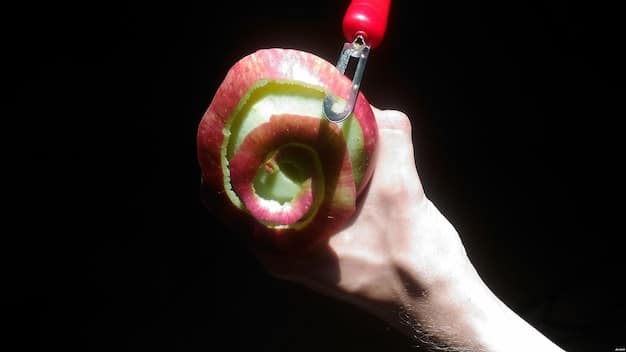
Equity, Access, and Commodification
Perhaps the most pressing ethical challenge in the near future concerns equity and access. Bioprinting complex organs will undoubtedly be incredibly expensive, at least initially. How will society ensure that these life-saving technologies are accessible to all who need them, regardless of socioeconomic status, rather than becoming a privilege of the rich? Without careful planning and policy, bioprinting could widen the healthcare gap, creating a new form of health apartheid. This raises questions about whether healthcare is a right or a commodity, and how innovative, costly therapies fit into existing healthcare systems.
- Cost and Affordability: The initial high cost of bioprinted organs may create a significant barrier to equitable access, potentially limiting this life-saving technology to a select few.
- Allocation and Scarcity: Even if costs decrease, decisions about who receives bioprinted organs, especially if supply lags demand, will be complex and require robust ethical frameworks, perhaps drawing on existing organ allocation principles.
- Commodification of Life: If organs can be manufactured on demand, does this lead to a commodification of biological material or even life itself, diminishing the intrinsic value of human tissue?
The psychological impact on recipients of bioprinted organs also warrants consideration. How might individuals perceive and integrate an “engineered” organ into their self-identity? While practical concerns often overshadow these existential questions, the psychological well-being of patients is a crucial ethical dimension. Furthermore, the potential for using bioprinted tissues or organoids for military applications or in ethically questionable research requires vigilant oversight and international regulation to prevent misuse.
Addressing these ethical considerations requires a multidisciplinary dialogue involving scientists, ethicists, policymakers, legal experts, and the public. Proactive engagement and the establishment of clear ethical guidelines are essential to harness the transformative power of bioprinting for the good of all humanity, preventing unintended consequences and ensuring that moral compass guides the scientific frontier.
Regulatory Pathways and Public Perception
The journey of bioprinted organs from research labs to clinical use is not solely a scientific endeavor; it is heavily influenced by evolving regulatory frameworks and significant public perception. How these complex technologies are perceived by society and how they are regulated will ultimately determine their clinical adoption and widespread impact.
Regulatory bodies, such as the Food and Drug Administration (FDA) in the United States, face the challenging task of classifying and overseeing bioprinted organs. Are they entirely new medical devices, or do they fall under tissue-engineered products, or even biologics? This classification is critical because it dictates the pre-market review process, including the types and phases of clinical trials required for approval. Given the novelty and complexity of bioprinted organs, regulators often adopt a cautious approach, demanding rigorous safety and efficacy data, which can take many years to accumulate.
The unique nature of bioprinted organs, often incorporating living cells and complex biological structures, necessitates specialized regulatory pathways. Traditional medical device regulations may not fully encompass the biological variability and long-term integration challenges associated with these products. Regulators must balance the desire to accelerate access to potentially life-saving therapies with the imperative to ensure patient safety and prevent unforeseen long-term side effects. This involves developing new guidelines, protocols for testing, and post-market surveillance strategies tailored to regenerative medicine products.
Shaping Public Opinion and Trust
Public perception plays a crucial role in the acceptance and funding of groundbreaking technologies like organ bioprinting. Initial reactions can range from fervent optimism to deep skepticism or even fear. Media portrayal, scientific communication, and public education campaigns significantly influence how the general public understands and feels about these advancements. Building trust in the scientific community and the regulatory process is paramount.
- Education and Awareness: Clear, understandable communication about the science, benefits, risks, and ethical considerations of bioprinting is essential to inform the public and counter misinformation.
- Transparency in Research: Openness about research progress, failed experiments, and ethical deliberations can foster trust and demonstrate a responsible approach to developing new technologies.
- Patient Advocacy: Stories from patients who could benefit from bioprinted organs can generate public support and empathy, highlighting the urgent need for such innovations.
Negative public perception, often fueled by sensationalized media or unsubstantiated fears, can lead to decreased public funding, stricter regulations, and even social resistance, effectively stalling scientific progress. Conversely, informed and positive public opinion can catalyze investment, accelerate regulatory processes, and ensure broader societal acceptance. Therefore, engaging in transparent and accessible dialogue with the public is not just good practice; it’s a strategic necessity for the field of bioprinting.
Navigating the intricate landscape of regulatory approval and carefully managing public perception are as vital as scientific breakthroughs for the successful translation of bioprinting technology. This dual challenge requires a collaborative effort between scientists, policymakers, ethicists, and communicators to ensure that bioprinted organs can fulfill their immense potential to transform healthcare responsibly and equitably.
The Future Landscape: Bioprinting’s Transformative Potential
Looking ahead, the transformative potential of bioprinting human organs extends far beyond simply replacing diseased tissues. This technology holds the key to revolutionizing personalized medicine, accelerating drug development, and even shaping our understanding of human biology in unprecedented ways. The future landscape, though still speculative in some aspects, promises profound shifts in healthcare delivery and scientific research.
One of the most significant implications is the promise of personalized medicine. Imagine a future where a patient needing a kidney transplant no longer waits years for a donor. Instead, cells are taken from the patient, an immunologically matched kidney is bioprinted, and then transplanted. This eliminates the need for lifelong immunosuppressant drugs, which have significant side effects and financial burdens. Such personalized organs would not only ensure greater compatibility but could also be designed to incorporate specific genetic traits or disease resistances, tailored to the individual’s unique needs.
Beyond whole organ replacement, bioprinting is poised to transform drug discovery and toxicology testing. Instead of relying on animal models or two-dimensional cell cultures, which often fail to accurately predict human responses, scientists can use bioprinted functional human tissues—”organs-on-a-chip.” These mini-organs, with their physiologically relevant structures and cell interactions, offer a more precise platform to test new drugs, evaluate their efficacy, and assess potential toxicities earlier in the development pipeline. This could significantly reduce the time and cost of drug development while improving safety and reducing reliance on animal testing.
Broader Applications and Ethical Foresight
The applications extend into regenerative therapies for injury and disease. Bioprinting could allow for the creation of on-demand bone grafts, cartilage patches, or even nerve conduits to repair damaged tissues more effectively than current methods. For chronic diseases like diabetes, bioprinting could eventually lead to the transplantation of functional pancreatic islet cells to restore insulin production, offering a potential cure. Furthermore, the technology aids in creating realistic disease models for research, allowing scientists to study disease progression and test new interventions in a precisely controlled, human-relevant environment.
- Personalized Drug Screening: Developing patient-specific disease models or “organoids” to test drug efficacy and toxicity, leading to more tailored and effective treatments.
- Enhanced Regenerative Therapies: Printing complex tissue constructs for repairing large-scale injuries, such as extensive burns or severe orthopedic trauma, with improved integration and function.
- Advanced Surgical Training: Creating realistic, anatomically precise bioprinted organ models for surgical simulation and training, reducing risks for patients and improving surgeon proficiency.
As the technology matures, it will also necessitate continued ethical foresight. The capacity to create increasingly complex biological structures will inevitably lead to new questions about sentience, consciousness, and what constitutes “life” in a laboratory setting. Debates around the moral status of advanced organoids that exhibit neural activity, for example, are already emerging. Proactive engagement with these profound ethical questions now will be crucial to ensure that the transformative potential of bioprinting is realized responsibly, guiding humanity towards a future where this powerful technology serves to alleviate suffering and enhance well-being for all.
The future of bioprinting is not just about organs; it’s about fundamentally reshaping our approach to health, disease, and the very boundaries of biological engineering. While challenges remain, the clear trajectory of innovation suggests a horizon where the ability to precisely engineer life will redefine what is medically possible.
| Key Point | Brief Description |
|---|---|
| 🔬 Latest Advances | Significant progress in vascularization, patient-specific iPSCs, and functional tissue printing for drug screening and basic research. |
| 🚧 Core Challenges | Overcoming hurdles in organ vascularization, long-term cell viability, scaling production, and replicating complex organ microarchitecture. |
| ⚖️ Ethical Dilemmas | Concerns include cell source ethics, human enhancement, ensuring equitable access, and preventing commodification of human tissues. |
| 🌐 Regulatory Outlook | Regulatory bodies are developing pathways, balancing rapid innovation with stringent safety and efficacy requirements for patient benefit. |
Frequently Asked Questions About Organ Bioprinting
▼
Bioprinting is a 3D printing technology that uses bio-inks containing living cells and biomaterials to build complex tissues and organs layer by layer. It starts with a digital model, which guides the precise deposition of bio-ink, allowing cells to grow and form functional structures mimicking natural organs.
▼
While significant advances have been made, fully functional, vascularized bioprinted organs for human transplantation are not yet commonly used. Research is ongoing, with successful trials for simpler tissues like skin or cartilage. Complex organs face challenges like vascularization and long-term viability before widespread clinical use.
▼
Key ethical concerns include the source of cells (e.g., embryonic vs. iPSCs), potential for human enhancement, equitable access to costly technology, and the commodification of human tissues. Ensuring these powerful tools benefit all of humanity, not just a privileged few, remains a central challenge.
▼
Bioprinting offers a potential long-term solution to the global organ donor shortage by creating organs on demand. By using a patient’s own cells, it could also eliminate issues of immune rejection, reducing the need for immunosuppressant drugs and improving transplant outcomes significantly over traditional methods.
▼
Organs-on-a-chip are small, bioprinted models of human organs that mimic their physiology. They are crucial for drug discovery and toxicology testing, providing more accurate human-specific data than animal models. This accelerates drug development, reduces costs, and minimizes reliance on animal testing, streamlining research.
Conclusion
The journey of bioprinting human organs is a testament to humanity’s relentless pursuit of innovation, bridging the realms of biology, engineering, and medicine. From groundbreaking scientific advances in vascularization and cell sourcing to the challenging yet imperative ethical and regulatory conversations, this field is not merely transforming healthcare; it is reshaping our understanding of what is possible within the human body. While significant hurdles remain before lab-grown organs become commonplace in operating rooms, the trajectory of progress suggests a future brimming with hope for millions suffering from organ failure. As we continue to push the boundaries of scientific discovery, responsible ethical stewardship and equitable access must remain at the forefront, ensuring that the promise of bioprinting truly serves the well-being of all humanity.
